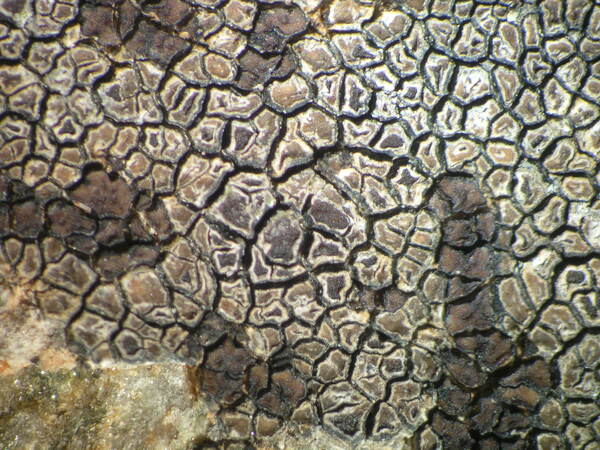Lecaimmeria cupreoatra (Nyl.) C.M. Xie
in Xie & al., MycoKeys, 87: 119, 2022. Basionym: Lecanora cupreoatra Nyl. - Not. Sällsk. Fauna Fl. Fenn. Förh., 8: 181, 1866.
Synonyms: Aspicilia cupreoatra (Nyl.) Arnold; Aspicilia olivacea Bagl. & Carestia; Bellemerea cupreoatra (Nyl.) Clauzade & Cl. Roux; Immersaria cupreoatra (Nyl.) Calat. & Rambold
Distribution: N - Piem (Isocrono & al. 2004), VA (Piervittori & Isocrono 1999), Lig (UPS-L-670367). C - Sar. S - Si (Calatayud & Rambold 1998, Campisi & al. 2020).
Description: Thallus crustose, episubstratic, areolate, 0.2-0.3 mm thick, brown, somewhat shiny, often delimited by a pale prothallus, forming up to several cm wide patches, the areoles contiguous, slightly concave to flat, angular, very irregular in outline, 0.3-0.8 mm wide, with a slightly raised, whitish-grey margin. Cortex 10-25 µm thick, brown in upper part, with an up to 20 µm thick epinecral layer; medulla white, I+ blue. Apothecia cryptolecanorine-aspicilioid, immersed, 1 per areole, 0.2-0.3(-0.4) mm across, round to very irregular in outline, with a brownish black, epruinose, flat disc and a whitish-grey thalline margin, the proper margin corresponding to the phenocortex and algal layer of the areoles. Proper exciple very thin, poorly developed; epithecium brown to greenish brown, c. 10 µm high, N+ purple; hymenium colourless, 100-110 µm high, I+ blue; paraphyses branched and anastomosing, 1.5-2 µm thick at base, the apical cells 3-5 µm wide; hypothecium colourless, c. 50 µm high, underlain by an algal layer. Asci 8-spored, narrowly cylindrical-clavate, with a I+ blue tholus and an internal, darker I+ tubular structure, the external gel I+ faintly blue, Porpidia-type. Ascospores 1-celled, hyaline, ellipsoid, 8-18 x 5-9 µm, halonate, non-amyloid. Pycnidia dark, immersed in the areoles, sometimes with a prominent ostiole. Conidia bacilliform. Photobiont chlorococcoid. Spot tests: K-, C+ faintly red, KC+ faintly red, P-. Chemistry: gyrophoric acid.Note: an arctic-alpine lichen of siliceous rocks starting the life-cycle on Buellia-species; most frequent in the Alps above treeline, extremely rare in Southern Italy. Records from lowland areas published after Nimis (1993) are certainly due to misidentifications, and are not cited here.
Growth form: Crustose
Substrata: rocks
Photobiont: green algae other than Trentepohlia
Reproductive strategy: mainly sexual
paras Buellia spp.
Commonnes-rarity: (info)
Alpine belt: rather rare
Subalpine belt: very rare
Oromediterranean belt: extremely rare
Montane belt: extremely rare
Submediterranean belt: absent
Padanian area: absent
Humid submediterranean belt: absent
Humid mediterranean belt: absent
Dry mediterranean belt: absent

Predictive model
Growth form: Crustose
Substrata: rocks
Photobiont: green algae other than Trentepohlia
Reproductive strategy: mainly sexual
paras Buellia spp.
Commonnes-rarity: (info)
Alpine belt: rather rare
Subalpine belt: very rare
Oromediterranean belt: extremely rare
Montane belt: extremely rare
Submediterranean belt: absent
Padanian area: absent
Humid submediterranean belt: absent
Humid mediterranean belt: absent
Dry mediterranean belt: absent

Predictive model
 DOLICHENS
DOLICHENS



